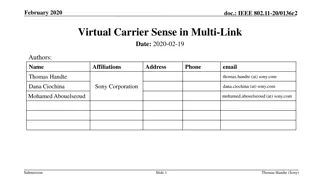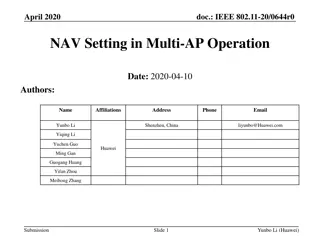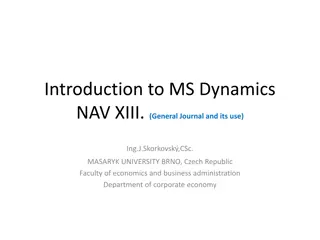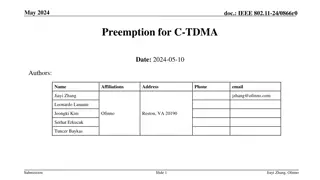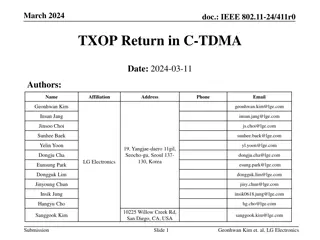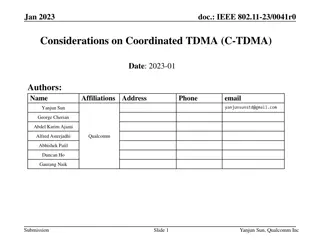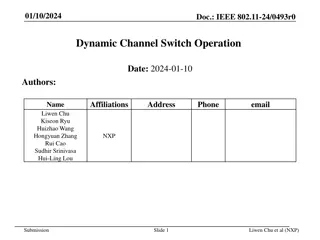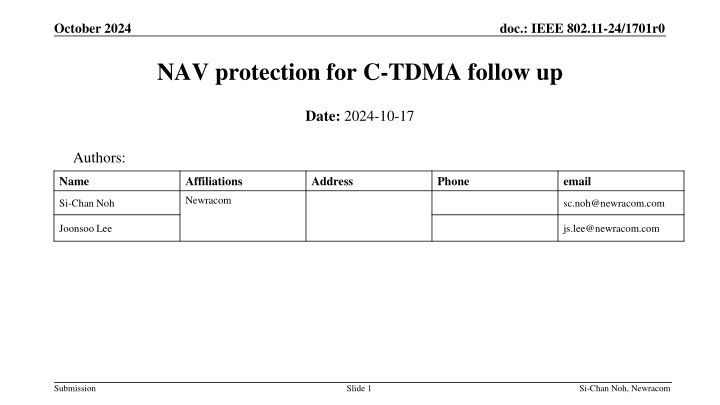
IEEE 802.11-24/1701r0 NAV Protection for C-TDMA Follow Up
Explore the protection aspects of TXOP sharing in the context of Coordinated Time Division Multiple Access (C-TDMA) within the IEEE 802.11-24/1701r0 framework. Addressing issues related to resource allocation and contention for the channel by Ultra High Rate (UHR) STAs within C-TDMA. Proposed solutions involve adjusting NAV timeouts and frame exchanges to enhance efficiency and effectiveness.
Download Presentation

Please find below an Image/Link to download the presentation.
The content on the website is provided AS IS for your information and personal use only. It may not be sold, licensed, or shared on other websites without obtaining consent from the author. If you encounter any issues during the download, it is possible that the publisher has removed the file from their server.
You are allowed to download the files provided on this website for personal or commercial use, subject to the condition that they are used lawfully. All files are the property of their respective owners.
The content on the website is provided AS IS for your information and personal use only. It may not be sold, licensed, or shared on other websites without obtaining consent from the author.
E N D
Presentation Transcript
October 2024 doc.: IEEE 802.11-24/1701r0 NAV protection for C-TDMA follow up Date: 2024-10-17 Authors: Name Affiliations Address Phone email Newracom Si-Chan Noh sc.noh@newracom.com Joonsoo Lee js.lee@newracom.com Submission Slide 1 Si-Chan Noh, Newracom
October 2024 doc.: IEEE 802.11-24/1701r0 Introduction To share the time resource of an obtained TXOP between APs, TGbn has been discussing coordinated TDMA (C-TDMA) [1] The protection of TXOP sharing between APs was discussed in [2] In this contribution, we discuss the protection aspects in TXOP return scenario within C-TDMA Submission Slide 2 Si-Chan Noh, Newracom
October 2024 doc.: IEEE 802.11-24/1701r0 Recap [2] : aspects of protection in C-TDMA The main goal is to allow UHR STAs to contend for the channel within the allocation time, which are only relevant to the sharing AP and does not affect the shared AP s BSS Based on the TXS procedure in 11be, where STAs should not reset their NAV after the NAVTimeout has expired unless the STA receives a CF-End frame, following TXS in 11be under the C-TDMA protocol could cause a waste of resources This means that the domain of TXS issues can be modified, as TXS is extended from a single BSS to multiple APs; Therefore, protecting all STAs during the allocation duration for the shard AP s BSS could be ineffective In here, we assume that the value of duration/ID field within the MU-RTS TXS TF is equal to the value of allocation duration field within user info field in MU-RTS TXS TF Submission Slide 3 Si-Chan Noh, Newracom
October 2024 doc.: IEEE 802.11-24/1701r0 Recap [2] : aspects of protection in C-TDMA The approaches to addressing modified TXOP sharing issues are as follows : Opt 1) When duration/ID field of MU-RTS TXS TF is equal to the allocation duration field of the frame In this case, reset its NAV after the NAVTimeout has expired when the UHR device is not associated with the sharing AP and only overhears MU-RTS TXS TF that is not for its BSS Opt 2) From the beginning, set the duration field of the MU-RTS TXS TF that doesn t cover all the shared AP s BSS frame exchanges The allocation duration field of the frame is different with duration field Submission Slide 4 Si-Chan Noh, Newracom
October 2024 doc.: IEEE 802.11-24/1701r0 Comparison between Opt1) and Opt 2) Opt 1) Opt 2) Duration field of MU-RTS TXS TF -Equal to the allocation duration field Not equal to the allocation duration field - Ex) Set to the length of time required to transmit the solicited response frame of TXS frame plus one SIFS Associated with the sharing AP (e.g., STA1-1) Pre- EHT After the NAVTimeout At the end of the duration field EHT At the end of duration field At the end of the duration field Hidden to the shared AP UHR At the end of the duration field At the end of the duration field Not associated with the sharing AP (e.g., OBSS STA) Pre- EHT After the NAVTimeout At the end of the duration field EHT At the end of the duration field At the end of the duration f ield UHR After the NAVTimeout At the end of the duration f ield Fairness issues Can occur between the EHT STA and other STAs Not occur between STAs *More details are in APPENDIX Submission Slide 5 Si-Chan Noh, Newracom
October 2024 doc.: IEEE 802.11-24/1701r0 Considering TXOP return in Opt 2) scenario Option 2) could be a better approach in terms of fairness issues between STAs However, it can affect a sharing AP when a shared AP returns its remaining portion of TXOP to the sharing AP For example, UHR STA that is associated with the sharing AP can access channel during allocation duration when we apply Opt 2) in MU-RTS TXS TF; At the same time, the shared AP returns its remaining TXOP to the sharing AP In this case, a collision can occur; therefore, the sharing AP may not be able to identify the returning TXOP To improve the reception of returned TXOP from the shared AP during C-TDMA, we can consider the following solution : TXOP return can be scenario-dependent; therefore; If TXOP return is available (e.g., requested from the sharing AP), set the NAV duration of UHR STAs that are associated with the sharing AP during the allocation duration The next slide shows an example Submission Slide 6 Si-Chan Noh, Newracom
March 2024 doc.: IEEE 802.11-24/1701r0 Considering TXOP return in Opt 2) scenario The sharing AP transmits an MU-RTS TXS TF with an indication of requesting the return TXOP An STA associated with the sharing AP and hidden to the shared AP extends the protection until the end of the allocated duration which is indicated in the user info field of MU-RTS TXS TF This can increase the probability of grabbing the returned TXOP from the shared AP Allocated time NAV protection of (MU-RTS TXS/CTS) Hidden STA to shared AP (OBSS STA) Hidden STA s frame exchange NAV protection of (MU-RTS TXS/CTS) Extend protection until the end of allocated time Shared AP Hidden STAs to shared AP (STA2-1) STA1-1 Sharing AP Control frame (MU-RTS TXS) with indication of TXOP return is requested Sharing AP STA1-2 STA2-1 Response (CTS) Return TXOP Shared AP OBSS STA Shared AP s BSS frame exchanges Submission Slide 7 Si-Chan Noh, Newracom
October 2024 doc.: IEEE 802.11-24/1701r0 Conclusions In this presentation, we discuss about how to increase reception of returned TXOP from the shared AP during C-TDMA when the duration field of MU-RTS TXS is not set as at the end of allocation duration Submission Slide 8 Si-Chan Noh, Newracom
October 2024 doc.: IEEE 802.11-24/1701r0 Reference [1] 24/0209r3, Specification Framework for TGbn [2] 23/1846r1, Protection of Extended TXOP Sharing Submission Slide 9 Si-Chan Noh, Newracom
October 2024 doc.: IEEE 802.11-24/1701r0 SP1 Do you agree that a sharing AP shall send a TXOP allocation frame(exact name TBD) to a single shared AP to share a time portion of its TXOP? The Duration field of the frame is set to the length of time required to transmit the solicited response frame plus one SIFS Submission Slide 10 Si-Chan Noh, Newracom
October 2024 doc.: IEEE 802.11-24/1701r0 SP2 Do you agree that STAs hidden from a shared AP reuse the allocation duration field within the TXOP allocation frame (exact name TBD) to extend protection, with the purpose of improving the sharing AP s reception of returned TXOP from the shared AP? The details are TBD Submission Slide 11 Si-Chan Noh, Newracom
October 2024 doc.: IEEE 802.11-24/1701r0 APPENDIX Submission Slide 12 Si-Chan Noh, Newracom
October 2024 doc.: IEEE 802.11-24/1701r0 STA s view when applying Opt 1) Network configuration : AP1: sharing AP; AP2 : shared AP STA1-1: associated with AP1 OBSS STA : not associated with AP1 Assumption : Duration field Equal to allocation duration STA format Pre-EHT STA : Apply the NAVTimeout EHT STA : Not apply the NAVTimeout(i.e., follow current spec rule) UHR STA Associated with the sharing AP : not apply the NAVTimeout Not associated with the sharing AP : apply the NAVTimeout Description : STA1-1 : Pre-EHT STA: contend the channel after NAVTimeout EHT/UHR STA : Set the NAV until the end of the allocation duration OBSS STA: Pre-EHT and UHR STA: contend the channel after the NAVTimeout EHT STA : Set NAV until the end of the allocation duration Overhear MU-RTS TXS MU-RTS TXS CTS (AP1) (AP2) STA1-1 Overhear MU-RTS TXS OBSS STA Submission Slide 13 Si-Chan Noh, Newracom
October 2024 doc.: IEEE 802.11-24/1701r0 STA s view when applying Opt 2) Network configuration : AP1: sharing AP; AP2 : shared AP STA1-1: associated with AP1 OBSS STA : not associated with AP1 Assumption : Duration field Not equal to the allocation duration Ex) set to the length of time required to transmit the solicited response frame plus one SIFS STA format Pre-EHT STA : Apply the NAVTimeout EHT STA : Not apply the NAVTimeout UHR STA : Not apply the NAVTimeout (i.e., if follow current spec rule) Associated with the sharing AP : not apply the NAVTimeout Not associated with the sharing AP : apply the NAVTimeout Description : STA1-1, OBSS STA : Pre-UHR and UHR STA: contend the channel after the end of the duration field (e.g., if the solicited response frame is CTS frame, the ending time is end of the CTS frame) Overhear MU-RTS TXS MU-RTS TXS CTS (AP1) (AP2) STA1-1 Overhear MU-RTS TXS OBSS STA Submission Slide 14 Si-Chan Noh, Newracom






